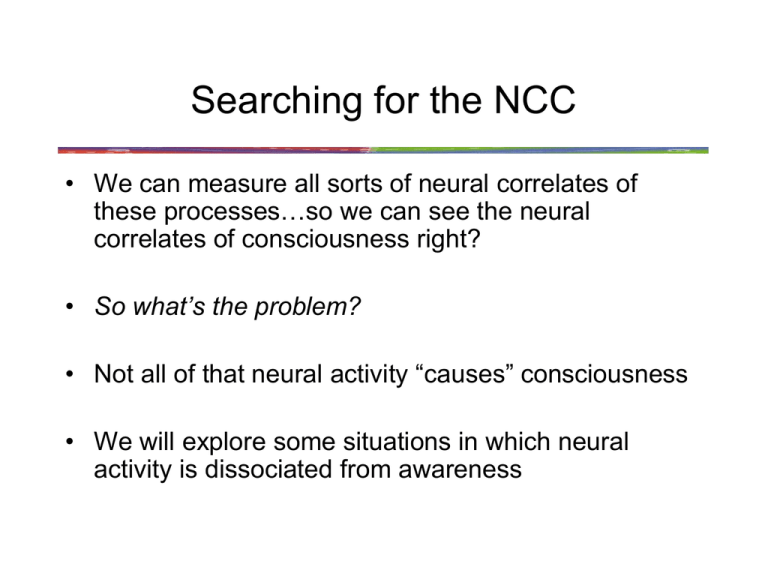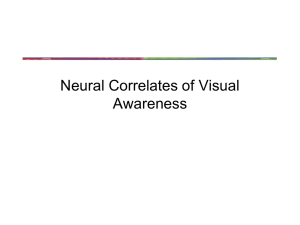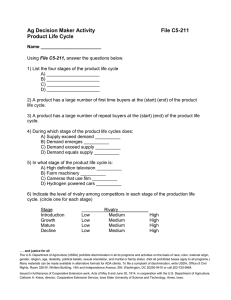Searching for the NCC
advertisement

Searching for the NCC • We can measure all sorts of neural correlates of these processes…so we can see the neural correlates of consciousness right? • So what’s the problem? • Not all of that neural activity “causes” consciousness • We will explore some situations in which neural activity is dissociated from awareness Dorsal and Ventral Pathways • V4 and V5 are key parts of two larger functional pathways: – Dorsal or “Where” pathway – Ventral or “What” pathway – Ungerleider and Mishkin (1982) • Magno and Parvo dichotomy arose at the retina and gives rise to two distinct cortical pathways Agnosia • Lesions (especially in the left hemisphere) of the inferior temporal cortex lead to disorders of memory for people and things • recognition and identification are impaired – prosopagnosia is a specific kind of agnosia: inability to recognize faces • explicit (conscious) decisions about object features are disrupted Agnosia • Goodale and Milner – Patient DF • Patient could not indicate the orientation of a slot using her awareness • Patient could move her hand appropriately to interact with the slot – whether visually guided or guided by an internal representation in memory Agnosia • Single dissociation of action from conscious perception • Dorsal pathway remained intact while ventral pathway was impaired • Dorsal Pathway seems to guide motor actions, at least for ones that need spatial information • Activity within the Dorsal Pathway seems not to be sufficient for consciousness Blindsight Lesions of Retinostriate Pathway • Lesions (usually due to stroke) cause a region of blindness called a scotoma • Identified using perimetry • note macular sparing X Retinocollicular Pathway independently mediates orienting • Rafal et al. (1990) • subjects move eyes to fixate a peripheral target in two different conditions: – target alone Retinocollicular Pathway independently mediates orienting • Rafal et al. (1990) • subjects move eyes to fixate a peripheral target in two different conditions: – target alone – accompanied by distractor Retinocollicular Pathway independently mediates orienting • Rafal et al. (1990) result • Subjects were slower when presented with a distracting stimulus in the scotoma (359 ms vs. 500 ms) Retinocollicular Pathway independently mediates orienting • Blindsight patients have since been shown to posses a surprising range of “residual” visual abilities – better than chance at detection and discrimination of some visual features such as direction of motion • These go beyond simple orienting - how can this be? Retinocollicular Pathway independently mediates orienting • Recall that the feed-forward sweep is not a single wave of information and that it doesn’t only go through V1 • In particular, MT seems to get very early and direct input Retinocollicular Pathway independently mediates orienting • Recall that the feed-forward sweep in not a single wave of information and that it doesn’t only go through V1 • In particular, MT seems to get very early and direct input • Information represented in dorsal pathway guides behaviour but doesn’t support awareness Searching for the NCC • What is needed is a situation in which a perceiver’s state can alternate between aware and unaware in ways that we can correlate with neural events • One such situation is called Binocular Rivalry Rivalrous Images • A rivalrous image is one that switches between two mutually exclusive percepts Binocular Rivalry • What would happen if each eye receives incompatible input? Left Eye Right Eye Binocular Rivalry • What would happen if each eye receives incompatible input? • The percept is not usually the amalgamation of the two images. Instead the images are often rivalrous. – Percept switches between the two possible images Binocular Rivalry • Rivalry does not entail suppression of one eye and dominance of another – it is based on parts of objects: Stimuli: Left Eye Percept: Right Eye Or Binocular Rivalry • Percept alternates randomly (not regularly) between dominance and suppression - on the order of seconds – What factors affect dominance and suppression? Time -> Binocular Rivalry • Percept alternates randomly (not regularly) between dominance and suppression - on the order of seconds – What factors affect dominance and suppression? – Several features tend to increase the time one image is dominant (visible) • Higher contrast • Brighter • Motion Binocular Rivalry • Percept alternates randomly (not regularly) between dominance and suppression - on the order of seconds – What factors affect dominance and suppression? – Several features tend to increase the time one image is dominant (visible) • Higher contrast • Brighter • Motion • What are the neural correlates of Rivalry? Neural Correlates of Rivalry • What Brain areas “experience” rivalry? • Clever fMRI experiment by Tong et al. (1998) – Exploit preferential responses by different regions – Present faces and buildings in alternation Neural Correlates of Rivalry • What Brain areas “experience” rivalry? • Clever fMRI experiment by Tong et al. (1998) – Exploit preferential responses by different regions – Present faces to one eye and buildings to the other Neural Correlates of Rivalry • What Brain areas “experience” rivalry? • Apparently activity in areas in ventral pathway correlates with awareness • But at what stage is rivalry first manifested? • For the answer we need to look to single-cell recording Neural Correlates of Rivalry • Neurophysiology of Rivalry – Monkey is trained to indicate which of two images it is perceiving (by pressing a lever) – One stimulus contains features to which a given recorded neuron is “tuned”, the other does not – What happens to neurons when their preferred stimulus is present but suppressed? Neural Correlates of Rivalry • The theory is that Neurons in the LGN mediate Rivalry Neural Correlates of Rivalry • The theory is that Neurons in the LGN mediate Rivalry • NO – cells in LGN respond similarly regardless of whether their input is suppressed or dominant Neural Correlates of Rivalry • V1? V4? V5? • YES – cells in primary and early extra-striate cortex respond with more action potentials when their preferred stimulus is dominant relative to when it is suppressed • However, – Changes are small – Cells never stop firing altogether Neural Correlates of Rivalry • Inferior Temporal Cortex (Ventral Pathway)? • YES – cells in IT are strongly correlated with percept Neural Correlates of Rivalry • Inferior Temporal Cortex (Ventral Pathway)? • YES – cells in IT are strongly correlated with percept • Why does area IT sound familiar to you? Neural Mechanisms of Consciousness? • So how far does that get us? • Not all that far – we still don’t know what is the mechanism that causes consciousness • But we do know that it is probably distributed rather than at one locus • Thus the question is: what is special about the activity of networks of neurons that gives rise to consciousness? – that’s still a very hard problem



